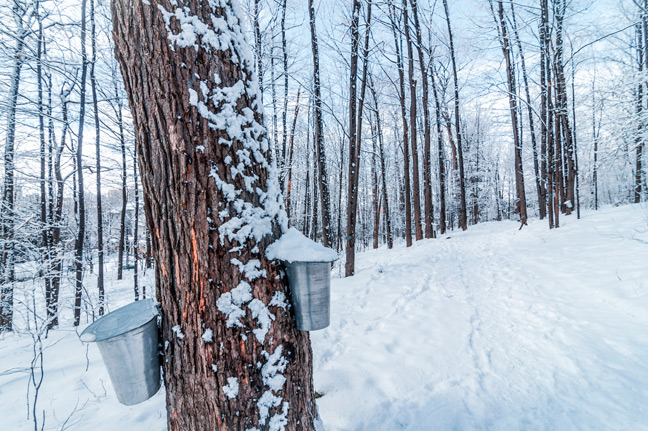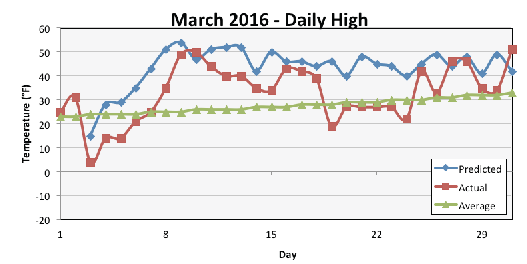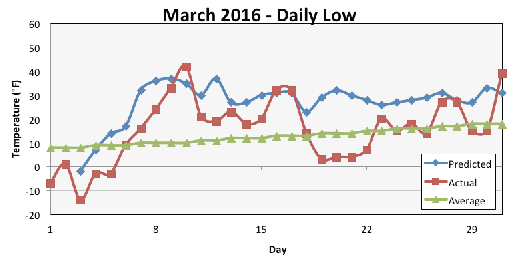UVM Proctor Page
Long-term average a better predictor of air temperature
Long-range weather forecasting a ‘work in progress’
By TIM PERKINS, UNIVERSITY OF VERMONT PROCTOR MAPLE RESEARCH CENTER | JAN. 2017
Whether it is choosing when to tap, or anticipating when the sap will run (or stop), maple production is intimately tied to the daily change in weather. Producers keep a close eye on their trees, and often an even closer eye on the weather forecast.
Although the weather prediction can provide some level of information about the possibility of impending sap runs, it can sometimes lead to a bit of angst if the forecasted weather appears that it will be too cold or too warm for good flows.
Twenty years ago, a five-day forecast was about all we could hope for. With improved satellites, more powerful computers, and better weather models, meteorologists added a few more days to the forecast about ten years ago to give us the forecast a full-week out, although everyone pretty much understands that the further out the forecast goes, the lower the reliability of the prediction.
Within the past few years, some websites forecast for a month. Seeing it on the computer screen gives us a sense that there must be some reasonable predictive power for the forecast to be that long.
The 2015-2016 winter in the northeast was very warm. As we entered the sugaring season, neither the short nor the long-range forecast, at least in north-central Vermont and many areas throughout the region, appeared favorable for a good crop. An extended period of very warm weather was forecast for the month of March, with daily high temperatures frequently in the upper-40’s or lower-50’s, and lows that barely fell below freezing on many occasions.
Looking at the forecast, and with the disastrous season of 2012 (record high temperatures in mid-March) still fresh in their minds, many maple producers got rather anxious about the prospects for the 2016 sugaring season, with the result that there was a great deal of chatter on various computer chat sites, on the phone, and in groups about how poor the season was going to be.
Early in March 2016, I took a screen snapshot of the long-range forecast from AccuWeather for Underhill Center, Vermont. A month later I went back and looked at the actual recorded high and low temperatures. I don’t mean to either endorse or to pick on AccuWeather -- there are other weather sites out there providing long-range forecasts and the story is probably pretty much the same. Other than the first few days, Accuweather© predicted that daily high and daily low temperatures in March 2016 would be considerably above the long-term average temperature for March in Underhill Center, Vermont (Figure 1).
In general, you would expect the daily high and daily low actual temperature to fall reasonably close to -- sometimes above and sometimes below -- the predicted high and low temperatures. In addition, you would expect that the forecast for the first 5-7 days would be closer to the actual tempertures than the long-range forecast. In the case of March 2016, both the predicted high and low temperatures throughout the entire month tended to fall considerably above the actual temperatures we experienced. Surprisingly, the short-range (5-7 day) forecast wasn’t much better than the long-range forecast. On average for the month, the maximum predicted temperature turned out to be over 10°F higher than the actual temperature experienced for BOTH the daily high and low temperature. On the high end, the predicted temperature forecast a temperature up to 27 and 28°F above the actual temperature for the daily high and low temperatures, respectively, and undershot the actual temperature by up to -9 and 8°F for the high and low daily temperature, respectively.
The long-term average daily high and low temperature turned out to be a far better predictor of air temperature than the prediction was, with deviations between the long-term average temperature and actual temperatures being less than half that of the difference between predicted and actual temperatures.
Perhaps March 2016 was just an “off” year for long-range weather forecasting – although my guess is that it wasn’t and that long-range forecasting is still a work in progress. Overall, looking at the short-term weather forecast can be somewhat useful in a general sense, but because maple sap flow is so closely tied to very small changes in temperature right around the freezing point, and because whether or not the sap flows on a particular day can also be influenced by snow, rain, and wind, it is only prudent to view the forecast as a general indicator for a few days, and to just be prepared for whatever we happen to get in terms of weather. In essence, the mysteries of weather and sap flow are part of what keeps the sugaring season so special.

































